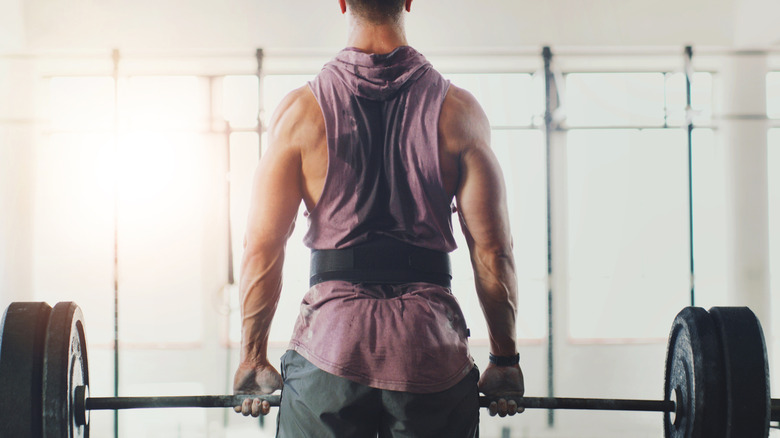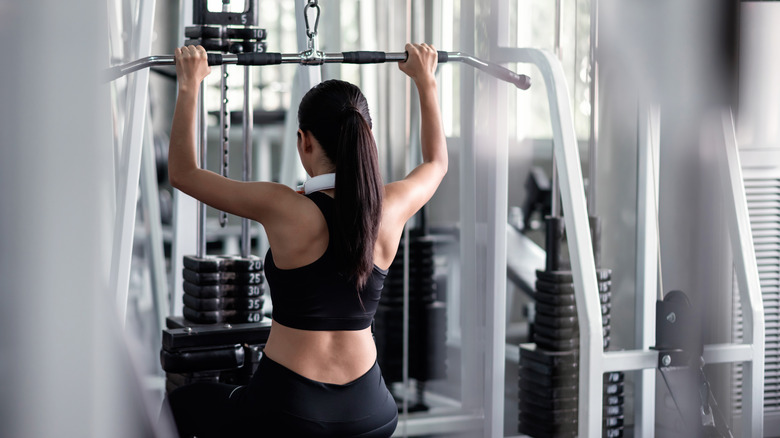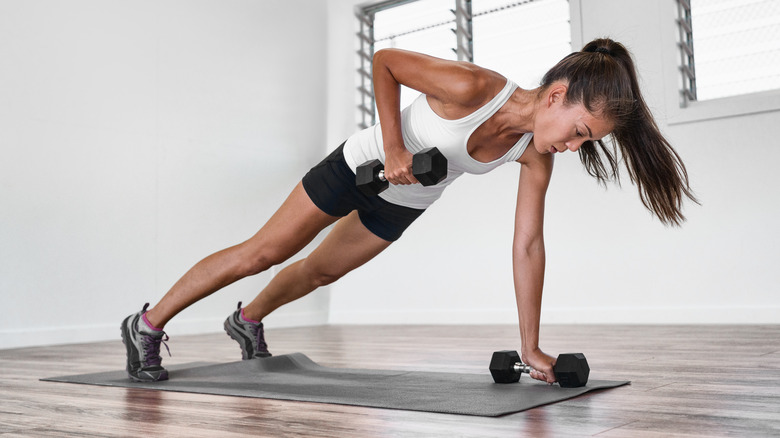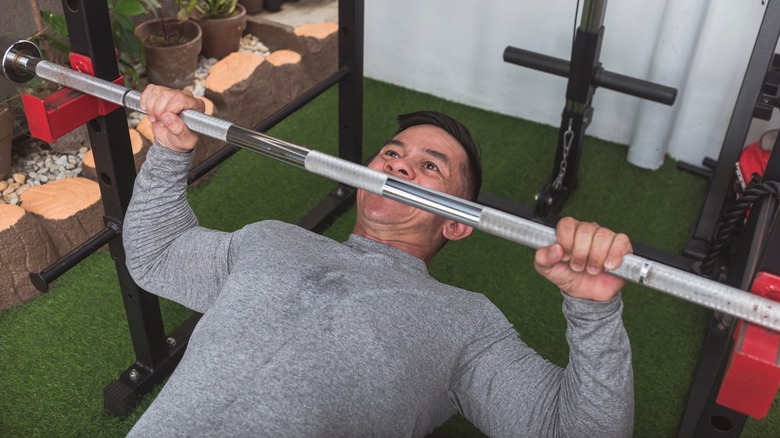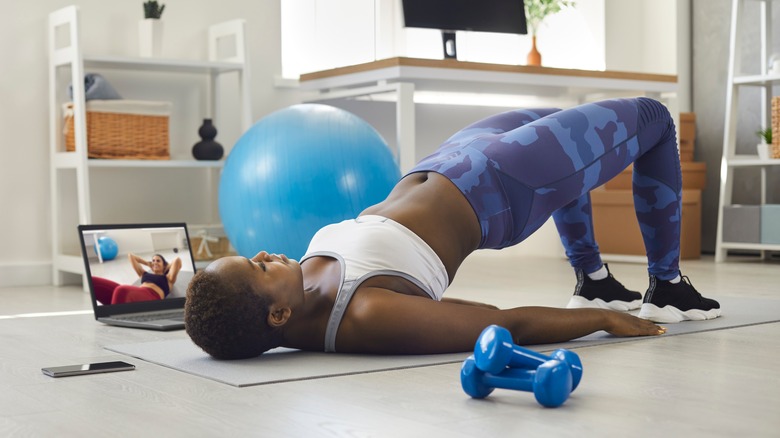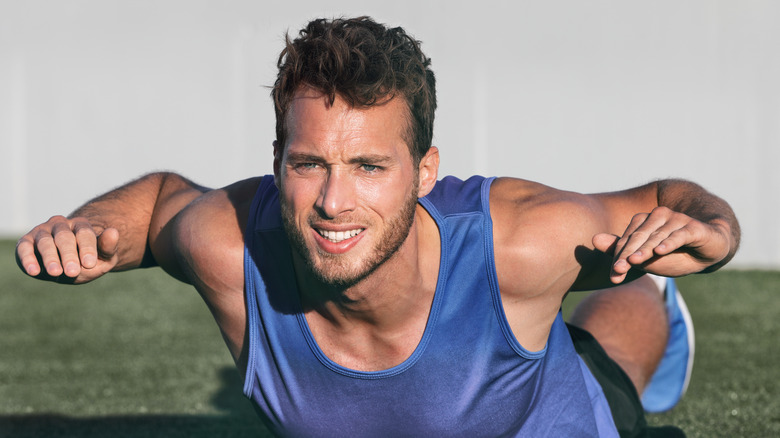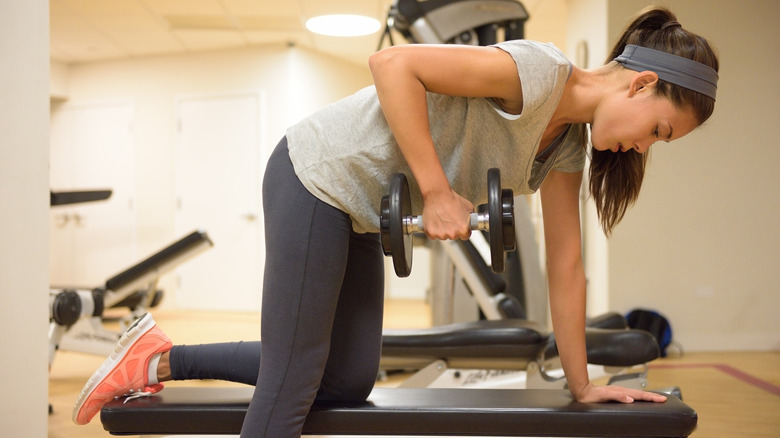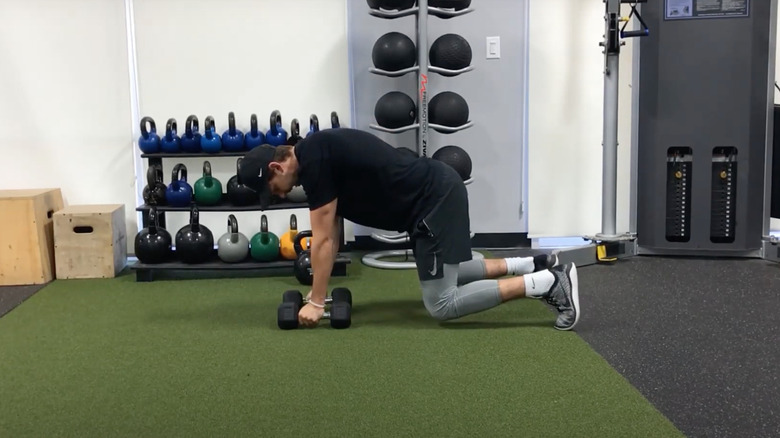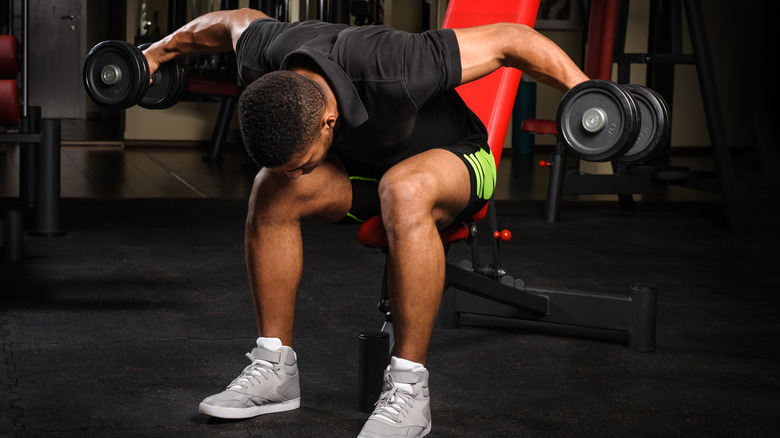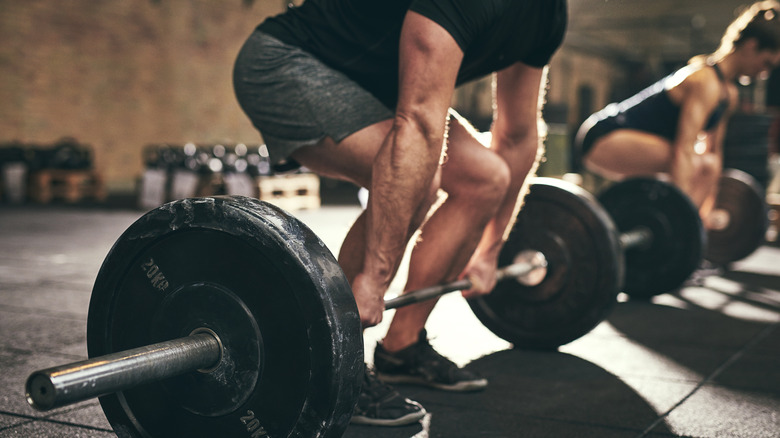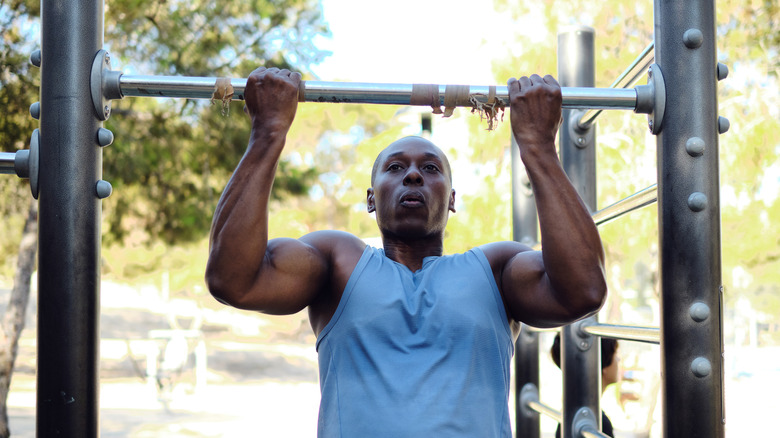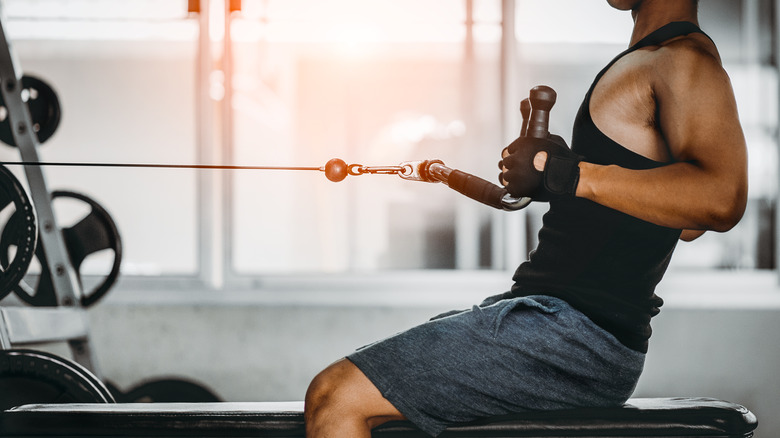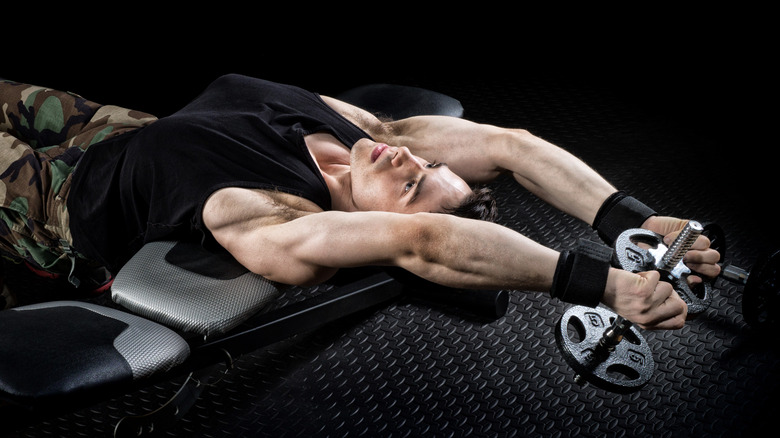The Best Exercises That Will Strengthen Your Back
Your back deserves a lot of love. A complex mass of joints, muscles, nerves, and the all-important spine, your back provides your body with essential postural, movement, and breathing support (per Ken Hub). With dozens of muscles helping to make up its structure, there are specific ones associated with a well-toned, V-shaped back — with exercises for the trapezius, latissimus dorsi, rhomboids, and erector spinae muscles all showing up regularly in gym regimens.
And there's good reason to keep your back in excellent shape, not least when it comes to working out the rest of your body. "The back is literally involved in every movement. Even if you aren't doing a 'back exercise,' per se, the back is still anchoring and stabilizing to support all arm gestures, core exercises, balance work and leg moves," says Daily Burn 365 trainer Cheri Paige Fogelman to NBC News. But exercises that target the back specifically can sometimes be harder to get familiar with than press-ups or bicep curls. And with all of those muscles back there, how do you know where to start? No worries, we've got you covered! Here's our best exercises to strengthen your back.
Lat pulldown
Chances are, if you've ever set foot in a gym, you've seen someone performing a lat pulldown. And we'd say it's definitely an exercise you'll want to include in your repertoire. Suitable for novices and gym pros alike, the lat pulldown targets your latissimus dorsi muscle (or lats), the large muscle that spans the width of your lower and middle back, and builds strength and size (per Pure Gym). Lat pulldowns are particularly good for newbies to back exercise as you can adjust the load — meaning you don't need a massive amount of prior strength to perform the movement, unlike with some bodyweight exercises like pull-ups.
To do a lat pulldown, sit on your lat pulldown machine, facing toward it, with the weight adjusted to your desired amount — if you're new to this exercise, less weight is probably better than more. Reach up and grasp the bar above you, with your hands at shoulder-width. Activating your lat muscles, pull the bar downward, until it reaches your upper chest. Hold briefly, then allow the weight to release, letting the bar travel back to the starting position while still holding onto it. Make sure to keep your core activated through the exercise, and try to limit using too much body momentum to pull the bar down.
Renegade row
The renegade row is not for the faint of heart, but boy does it pay off. Combining a plank and a dumbbell row, renegade rows target your upper back and erector spinae muscles, as well as your abs, quads, forearms, shoulders, and triceps, says Verywell Fit. How's that for efficiency? The caveat to extolling the benefits of the renegade row, however, is that you'll need a fairly good base level of fitness to do it, due to the difficulty of performing a dumbbell row while holding a one-armed plank simultaneously.
To start, get on your hands and knees, limbs stacked in alignment, with a dumbbell in each hand resting on the floor. Stepping your feet out, move into a plank, with your hands stabilized on each dumbbell. Slowly shifting your bodyweight onto one of your hands, pull the other hand's dumbbell off the ground, activating your back muscles as you row the dumbbell up. Lower it to the ground, and perform the same movement on the other side. One of the most common mishaps during a renegade row is a rotation of the hips and shoulders, as Men's Health says — so try as much as possible to keep them facing the ground as you lift the dumbbell. Don't be afraid to start light — focus on keeping your plank steady instead of using the biggest weight you can muster.
Inverted row
In our opinion, the inverted row is underrated. If you find pull-ups too tricky, this bodyweight exercise can bridge the gap between limited back strength and abundant pull-up action, by targeting your lats and smaller stabilizer muscles, increasing strength and function (per Coach Magazine). Aside from its awesome back benefits, it's also a move that you don't need a gym to perform: Any park that has a parallel bar, bike rack, or sturdy table can be used to do an inverted row. Just make sure that anything you're doing an inverted row on is well-braced and strong, with no risk of breaking or toppling during the exercise.
You'll need to start your inverted row lying on your back under your chosen bar or object. Reach up, and hold on with both hands in an overhand grip, keeping your body straight. Squeezing your back, pull your chest up to meet your hands, pausing momentarily at the top, and then lower yourself back to the floor. Don't allow your hips to either sag or jut out during the exercise, and keep your neck relaxed as you do so.
Bridges
The bridge is a frequent flyer in workout plans, and we think it earns its place. This simple exercise focuses on your lower body and is particularly effective for the lower back and any issues that you might have around it, as well your all-important glutes. According to trainer Isaac Boots, the bridge will "rehabilitate anything that's going on in your lower back and even your hips, but it makes your a** look amazing. So it's a double win." (via Well+Good). Placed at the end of a workout, during which you may have accumulated lower back strain, a set of bridges can help to realign the body and build all-important strength.
And doing a bridge is a piece of cake. Lie on your back with your knees bent and your feet placed flat on the floor, explains Verywell Fit. Engaging your abs and glute muscles, lift your hips away from the floor toward the ceiling, until your body makes a straight line from chest to knees. Hold this position for 20 to 30 seconds, then slowly lower your hips back to the starting position.
Reverse snow angels
It can often seem like training your back is reliant on gym equipment or weights. But bodyweight back exercises should be an indispensable part of your workout repertoire — and the reverse snow angel is an excellent move to include. Reverse snow angels activate the muscles in the upper back, and are notably useful to support correct posture, according to Invictus Fitness. As a bonus, you get to remind yourself of the days spent making snow angels in the yard.
The exercise, which also improves range of motion in the back, is begun lying on your stomach, says Aaptiv trainer Ackeem Emmons to Aaptiv. With your arms and legs extended, lift your chest away from the ground, keeping your neck relaxed. "Arms are extended in front, [and] with your palms facing down, pull elbows down towards to your obliques, or lower back, and repeat. With every rep, you should feel retraction and protraction in the scapula," says Emmons. Aim for 20 reps for three sets if you're a beginner, resting for a few minutes between sets.
Bent-over row
There's a reason why the bent-over row is such a popular back exercise: It hits your back in ways that few other movements can. When performed with good form, bent-over rows target your lats, in addition to building your biceps, says Men's Health. Performed with either a barbell or pair of dumbbells, begin the bent-over row by standing with your feet shoulder-width apart and holding your weight in front of you. Hinging at the hips, bend your upper body, keeping your back straight, until it's parallel with the floor. In a rowing motion, slowly pull the weight up toward your chest, controlling the movement and squeezing your back as you do so. Lower the weight to the starting position, and repeat.
Although the bent-over row may seem simple, there are a few common mistakes to watch out for. "You see a lot of people throwing the weight slightly forward. This brings your anterior deltoids (shoulders) into play, when the exercise should be focusing on your lats," warns personal trainer Scott Laidler to Men's Health. Equally as important to bear in mind is the weight you're using. "This is one exercise that lots of people get injured on," says Laidler. Choosing weights that are too heavy will diminish your form and heighten the risk of harm.
Single-arm row
Mastering the single-arm row will give you a one-way ticket to back strength. While single-arm rows mainly work your lat muscles, your arms, shoulders, and hips also come to the party, making this move not only great for your back but also your upper and mid-body generally (per Verywell Fit). The single-arm nature of the exercise allows you to isolate the muscles on one side of your body at a time — just don't forget to repeat the movement on the other side, to limit building up your muscles unevenly.
Start the move by standing next to an exercise bench, and placing your left knee on it, your right leg planted on the floor, says ACE Fitness. Bend over so your body's parallel to the bench, and place your left hand on the bench to brace your body, holding a dumbbell in your right hand. Contracting your abs and back, slowly row the dumbbell up to your chest, bending at the elbow as you do so. Make sure your body remains aligned while you do this, avoiding rotation at the hips. Hold the weight there briefly, and then lower it to the starting position. It's useful to do this exercise with a mirror next to you, to keep an eye on your form.
Bear plank row
Most people have seen the standard back exercises out there, but we like to mix it up. That's why we're thoroughly recommending giving bear plank rows a try. Like a renegade row, a bear plank row works an abundance of muscles, with your core and arm muscles getting a workout while you also train your back (per Men's Health). Where the bear plank row has the edge, though, is in its limiting of hip rotation, a common problem in renegade rows that can alter your form and reduce the move's effectiveness.
Start by getting into a bear crawl, with a dumbbell in each hand, resting on the floor. Make sure your arms and legs are under your shoulder and hip joints, your back is straight, and your knees aren't drooping. Keeping your core strong, pull one dumbbell from the ground and, bending at the elbow and with your upper arm moving back, row it up to your chest. Your hips and shoulders should remain facing the floor as much as possible. When the weight's reached full height, slowly lower it to the ground, and perform the movement in full on the other side for a complete rep.
Reverse fly
A standard fly motion is great for working out your chest, but reversing it can bring some serious back benefits. The reverse fly trains your upper back muscles, and specifically targets your rear shoulders, or posterior deltoids, says Verywell Fit. Working out both areas of the back improves posture and balance, and hitting your rear delts can assist in improving the width (to a degree) of your shoulders, which not only helps with visual presentation of your back in general but also reduces injury risk during other exercises, advises Healthline.
The reverse fly is best done with a pair of dumbbells. Stand with your feet at shoulder-width, and keeping your back straight, bend forward at the hips until your upper body is almost parallel with the ground. Your dumbbells should be hanging at each side of your body, and your knees slightly bent. Exhaling, bring your arms out to each side of your body, pulling the dumbells back until they're at shoulder-level (if it helps, visualize your arms coming out like wings). Lower the weights to the starting position, for one rep. A reverse fly can also be done sitting down, on the end of an exercise bench. Try not to use momentum to do the movement: If you have to work too hard, you're likely using weights that are too heavy.
Deadlift
Beloved by bodybuilders and Olympians alike, the deadlift is an exercise we could all stand to do more of. This effective compound exercise hits more muscles than you can count on one hand, with your hamstrings, glutes, abs, and obliques all getting involved, says SELF. But it's the muscles it trains in your back that earn this movement its place on our list, with a correctly-performed deadlift training your rhomboids, trapezius, and lat muscles.
Perfecting a deadlift is an art in itself, and focusing on the correct form is essential to get the most out of this exercise. To do the move using a barbell, stand with your feet at shoulder-width, with a barbell in front of you. Bending your knees a little and sending your hips back, bend over and grasp the barbell in an overhand grip, hands placed as wide as your shoulders. Driving through your feet, with straight arms lift the barbell off the ground, bringing your hips forward until your body is up straight. Lower the weight to the ground using the same motion.
To make sure your back muscles are properly involved, "Pretend like you're squeezing an orange in your armpits during your setup and maintain that during the execution of the lift," suggests certified strength and conditioning specialist Tony Gentilcore to SELF. "This will fire up your lats and transfer force from your lower body to your upper body, which can prevent your back from rounding and straining."
Pull-ups
Pull-ups are pretty much the go-to exercise for back strength, and we can definitely see why (even if we can't quite do them yet). The pull-up is highly effective for training a range of back muscles, including your latissimus dorsi and trapezius, as well as the infraspinatus and erector spinae muscles, which support spine and shoulder blade function (per Healthline). As a compound exercise, a pull-up also works your shoulder and forearm muscles and can develop stronger grip strength.
Stand under your pull-up bar, and using an overhand hold, grasp it a little wider than shoulder-width, explains Sweat. On an exhale, engage your back, core, and arms, and proceed to pull your body up toward the bar, until your chest reaches it and your chin moves past your hands. Try as much as possible to keep your legs still, and your shoulders aligned. Hold at the top briefly, and then slowly lower yourself down until you're hanging off the bar. Crucially, you'll want to warm up your back with some other exercises first. "Most of what we do each day—sitting at work, laying in bed, looking at phones and laptops—fails to engage the back properly. Be sure to warm up by doing some work with bands, or a few single-arm rows, before graduating to pull-ups for the day," suggests trainer Idalis Velazquez to GQ.
Seated row
The seated row is a simple and effective exercise that your back will thank you for. Performed by using a seated row machine or resistance bands looped around a sturdy object, seated rows fire up multiple back muscles, including your rhomboids, trapezius, and lat muscles, says Healthline. And your biceps may also get a workout too, thanks to the pulling motion that seated rows use.
To do a regular seated row using a machine, start by sitting straddled on the bench, making sure that it's adjusted properly for your height. Your feet should be sitting flat on the floor or correctly on the footpads. Ensure that you've set the machine to the correct weight, then grab the bar or grip in front of you, and keeping your core engaged, pull it back to meet your chest, keeping your elbows tucked in as you do so. Keep the bar contracted for a second, and then gently return to your starting position. Repeat 12 to 15 times for a full set. If you're new to the exercise, it's advisable to start with a lower weight than you think, and work on getting your form perfect.
Dumbbell pullover
If you're tired of doing endless rowing variations to build up back muscles, the dumbbell pullover could be the one for you. Requiring an exercise bench and pair of dumbbells, this movement utilizes both the front and back muscles, working out your latissimus dorsi and your pecs in one fell swoop (per Verywell Fit). As a bonus, your triceps can also benefit from the exercise, and the activation through your core muscles keeps them engaged too.
Begin by sitting on the end of your exercise bench, and then slowly lay down on your back across its length. Make sure that your neck and head aren't hanging off the end of the bench. Holding a dumbbell in each hand, raise your hands above your head, with your palms facing inward. Then, while inhaling, allow the weights to move back and over your head, moving in an arc until your arms are extended in line with your body. Exhaling, slowly move the weights back to the first position. For a dumbbell pullover, safety is key. You're going to be holding weights above and near your head for the majority of it, so make sure you're not using dumbbells that are too heavy. As the exercise requires a full range of motion in the shoulder, it's best avoided by those with limited shoulder mobility.

